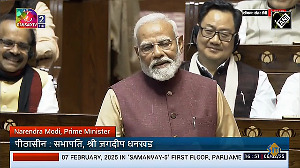Two of the committee members, AV Rajwade and Surjit S Bhalla, have expressed reservations about some of the recommendations in the report.
On the proposal to ban fresh inflows in the form of participatory notes, Rajwade says the Lahiri Committee had gone into the issue in more detail and its views -- that participatory notes be allowed -- should be respected.
The Lahiri Committee on "Encouraging FII flows and checking the vulnerability of capital markets to speculative flows" had debated the issue of PNs in detail.
While taking note of the possibility of misuse of the instrument, the panel had favoured the continuation of PNs with the rider that "Sebi should have full powers to obtain information regarding the final holder/beneficiaries or of any holder at any point of time in case of any investigation or surveillance action."
PNs are instruments akin to contract notes issued by registered FIIs to overseas clients, who are not eligible to directly invest in the capital market. The investments are issued against an underlying security thereby helping the holder to benefit from the capital appreciation or income from that underlying security.
Regarding the recommendation to progressively increase the ceiling on FII investment in the rupee bond market, he says such investments -- both in G-Sec and corporate bonds -- should be freely allowed.
Given the huge fund requirements of the infrastructure sector, there is obviously a need to lengthen maturities in the bond market, and broaden the base of investors, particularly longer term investors like pension funds.
Since FII entry had the potential to create volatility in exchange and interest rates, a lock-in period could be prescribed, Rajwade says.
About the facilities for residents to transfer capital up to $25,000 a year, he says the facility is aimed at giving an opportunity to domestic savers to diversify investments, admittedly one of the objectives of capital account liberalisation.
But the risk-reward relationship of the facility for residents is skewed more on the risk side, with rewards limited to a narrow section. "In the case of capital inflows as well, the risk of reversal was there but, in my view, the rewards outweigh the risk," he said.
In his dissent note, Bhalla says the report on many occasions misses the "big picture" fact that India is a very different economy, and that the world environment is considerably different from when the original capital account committee report was written.
The committee, in its own perception, makes a "bold" move by recommending that Indian residents be allowed to remit up to $100,000 per year by the end of 2008-09.
It is useful to recall that the 1997 committee's recommendation was that this limit should have been reached fully nine years earlier ie by 1999/2000. So, in a bid to reform, the committee has actually regressed backwards.
"What the Indian resident may be allowed to remit, and that too in 2008/09, is about 30 per cent less in real terms than she was recommended to remit in 1999/00. This is surely not a move towards 'fuller' capital account convertibility," he said.
Bhalla says the report states that the exchange rate has been well managed in the last few years, etc. Yet the report also recommends that the RBI should be constrained to operate the exchange rate in a band of 5 per cent around the REER; and when the REER moves beyond the band, the RBI "should ordinarily intervene."
Examination of the various series on REER maintained by the RBI (different country combinations, different base years) shows that the Indian rupee has moved in a very narrow REER band for the last 14 years.
The reason for this "constancy" is that the rupee has been managed by the RBI; the RBI has implicitly "forced" the rupee not to deviate from the real 1993/94 level.
Given that the rupee management has fulfilled every explicit requirement of the committee's objectives, then why does the committee recommend a rigid rule for forex management, especially when countries have moved away from such rules in the last 10 years, and especially since the East Asian crisis of 1997?







 © 2025
© 2025